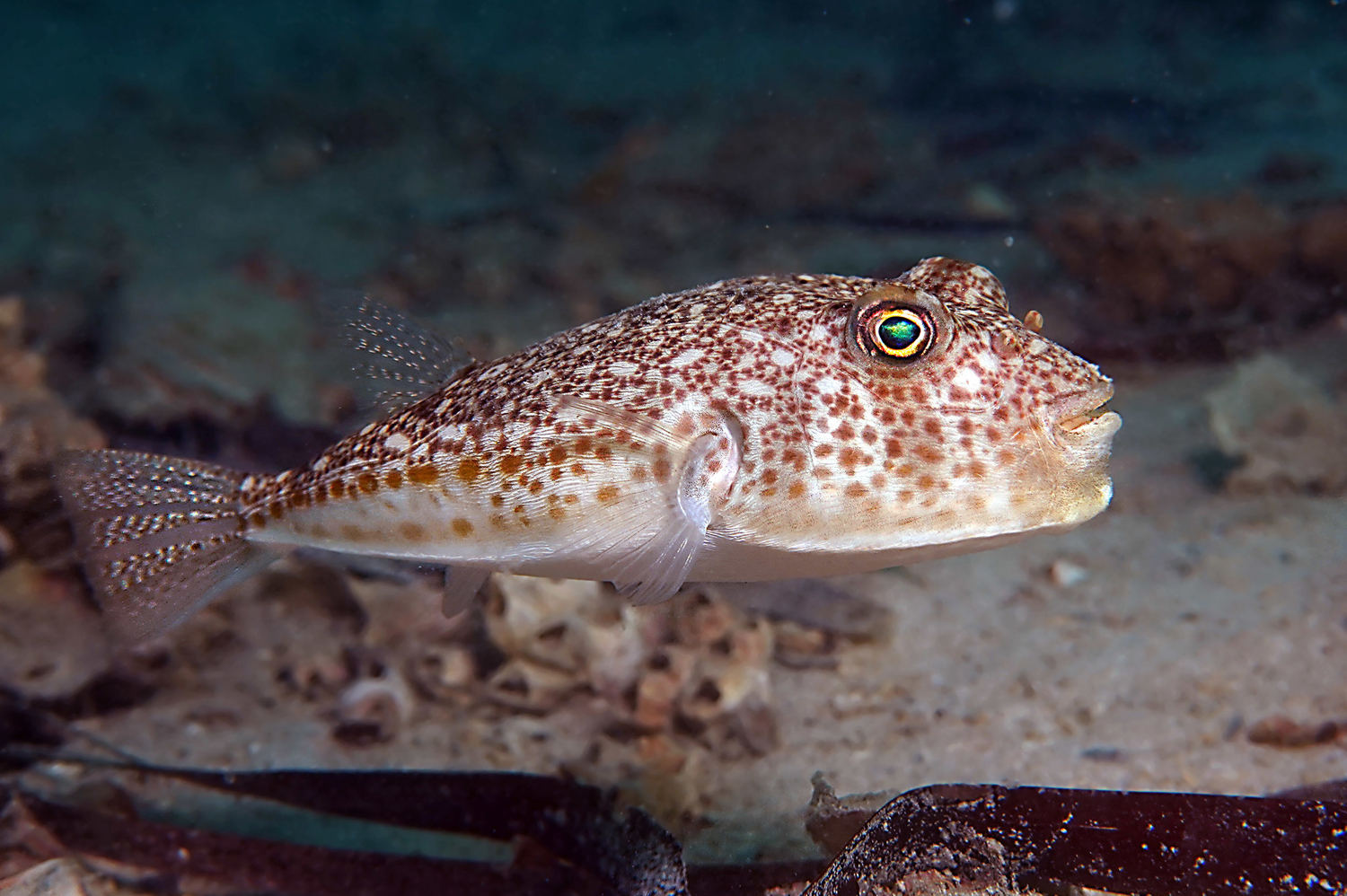Hicks' Toadfish, Torquigener hicksi Hardy 1983
Other Names: Hick's Toadfish

Hicks' Toadfish, Torquigener hicksi, at Coogee Beach, Cockburn, Western Australia, October 2020. Source: Glen Whisson / iNaturalist.org. License: CC By Attribution-NonCommercial
Cite this page as:
Bray, D.J. 2021, Torquigener hicksi in Fishes of Australia, accessed 01 Jul 2025, https://fishesofaustralia.net.au/Home/species/1295
Hicks' Toadfish, Torquigener hicksi Hardy 1983
More Info
|
Distribution |
Northwest Shelf (and possibly south to Rottnest Island), Western Australia, and off Ashmore Reef in the Timor Sea, to north of Darwin, Northern Territory, and off the northern Great Barrier Reef, Queensland, to Wreck Bay, New South Wales. |
|
Features |
Dorsal fin 10; Anal fin 8; Pectoral fin 16; caudal rays 11; Vertebrae 8 + 12 (holotype only). Body elongate, rounded dorsally, flattened ventrally, tapering to a narrow caudal peduncle; head length 3. I in SL. Eye moderate, slightly elongate and dorsally adnate, upper border just below dorsal profile, lower border well above level of mouth corner. Least fleshy interorbital distance less than 15.0 times in SL. Pectoral fins dorsally elongate, rounded, first ray very short; top of base just below lower margin of eye; dorsal fin elongate, bluntly pointed. |
|
Colour |
In preservative: holotype brownish-grey above, with pale spots and dots extending from level of eyes onto caudal peduncle; cheeks light grey with darker spots, and a brownish patch extending from anterior to the branchial aperture to over the pectoral fin base; lateral surface behind pectoral fin base pale, with indistinct greyish patches immediately behind the fin base, produced into a chain-like series of brownish-grey markings extending to the caudal fin base; chin dirty grey; belly white; pectoral, dorsal, and caudal fins greyish, anal fin pale. |
|
Etymology |
The species is named for Dr Geoffrey R. F. Hicks, a close friend and colleague of the author. |
|
Species Citation |
Torquigener hicksi Hardy 1983, Journal of the Royal Society of New Zealand 13(1/2): 25. Type locality: 33 km NE of Cape Moreton, Queensland, depth 128 m. |
|
Author |
Bray, D.J. 2021 |
|
Resources |
Hicks' Toadfish, Torquigener hicksi Hardy 1983
References
Allen, G.R. 1997. Marine Fishes of Tropical Australia and South-east Asia. Perth : Western Australian Museum 292 pp. 106 pls.
Allen, G.R. & Swainston, R. 1988. The Marine Fishes of North-Western Australia. A field guide for anglers and divers. Perth, WA : Western Australian Museum vi 201 pp., 70 pls.
Hardy, G.S. 1983. Revision of Australian species of Torquigener Whitley (Tetraodontiformes: Tetraodontidae), and two new generic names for Australian puffer fishes. Journal of the Royal Society of New Zealand 13(1/2): 1-48 https://doi.org/10.1080/03036758.1983.10415335
Hoschke, A., Whisson, G. & Moore, G.I. 2019. Complete list of fishes from Rottnest Island. pp. 150-161, in Whisson, G. & Hoschke, A. (eds). The Rottnest Island fish book. 2nd ed. Perth : Aqua Research and Monitoring Services, 166 pp.
Johnson, J.W. 2010. Fishes of the Moreton Bay Marine Park and adjacent continental shelf waters, Queensland, Australia. pp. 299-353 in Davie, P.J.F. & Phillips, J.A. Proceedings of the Thirteenth International Marine Biological Workshop, The Marine Fauna and Flora of Moreton Bay. Memoirs of the Queensland Museum 54(3)
Larson, H.K., Williams, R.S. & Hammer, M.P. 2013. An annotated checklist of the fishes of the Northern Territory, Australia. Zootaxa 3696(1): 1-293
Lowe, G.R. & Russell, B.C. 1990. Additions and revisions to the checklist of fishes of the Capricorn-Bunker Group, Great Barrier Reef, Australia. Great Barrier Reef Marine Park Authority. Special Publication Series 19: 1-27
Sainsbury, K.J., Kailola, P.J. & Leyland, G.G. 1984. Continental Shelf Fishes of Northern and North-Western Australia. Canberra : Fisheries Information Service 375 pp. figs & pls.
Shao, K., Liu, M., Jing, L., Hardy, G., Leis, J.L. & Matsuura, K. 2014. Torquigener hicksi. The IUCN Red List of Threatened Species 2014: e.T193735A2268970. http://dx.doi.org/10.2305/IUCN.UK.2014-3.RLTS.T193735A2268970.en. Downloaded on 07 June 2019.




